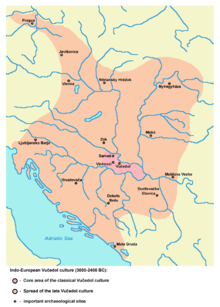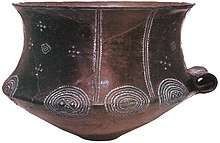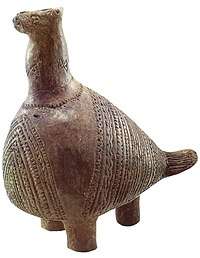Vučedol culture
The Vučedol culture (Croatian: Vučedolska kultura) flourished between 3000 and 2200 BC[1] (the Eneolithic period of earliest copper-smithing), centered in Syrmia and eastern Slavonia on the right bank of the Danube river, but possibly spreading throughout the Pannonian plain and western Balkans and southward. It was thus contemporary with the Sumer period in Mesopotamia, the Early Dynastic period in Egypt and the earliest settlements of Troy (Troy I and II). Some authors regard it as an Indo-European culture.[2]
 | |
| Geographical range | North-west Balkans, Pannonian Plain |
|---|---|
| Period | Chalcolithic Europe |
| Dates | c. 3000 BC – 2200 BC |
| Major sites | Vučedol, near Vukovar, Croatia |
| Preceded by | Baden culture, Butmir culture, Kostolac culture |
| Followed by | Nagyrév culture |
Location
Following the Baden culture, another wave of possible Indo-European speakers came to the banks of the Danube. One of the major places they occupied is present-day Vučedol ("Wolf's Valley"), located six kilometers downstream from the town of Vukovar, Croatia. It is estimated that the site had once been home to about 3,000 inhabitants, making it one of the largest and most important European centers of its time. According to Bogdan Brukner, proto-Illyrians descended from this wave of Indo-European settlers.[3]
The early stages of the culture occupied locations not far from mountain ranges, where copper deposits were located, because of their main invention: making tools from arsenical copper in series reusing double, two-part moulds.

Cultural phases
The Vučedol culture developed from two older eneolithic cultures: the Baden culture, mainly in the Pannonian plain, and the Kostolac culture in northern Serbia and western Romania, so the primary region of Vučedol development is eastern Croatia and the Syrmia region.
The archaeological stratigraphy of the Vučedol culture can be divided into four phases:
- Preclassic period A
- Early classic period B1
- Classic period B2
- Period of expansion with regional types, C:
- East Croatian (Slavonian-Syrmian type)
- West Bosnian (Hrustovac type)
- South Bosnian (Debelo Brdo type)
- North Serbian (Đurđevačka Glavica type)
- West Croatian-Slovenian (Ljubljana Marsh type)
- Transdanubian (Pannonian Hungarian type)
- East Austrian-Czech type
The Vučedol culture is the final eneolithic culture of the region, displaying characteristically common use of the war axe in its "Banniabik" form. Cult objects suggest the practice of new cults very different from the Neolithic Magna Mater conception: cult of the Deer,[4] womb-shaped solar motives, figures of women in clothes without sexual or fertility decoration, symbols of double axe. In pottery, new forms and a new rich decoration, are characterized by the spectacular find, the Vučedol dove. The Vučedol culture exploited native copper ores on a massive scale. The settlement sites destroyed earlier eneolithic settlements, and new Vučedol settlements also developed in regions where none previously existed.
The rise of a dominant hunter-warrior class is a preview of the changes that will be characteristic for the east and middle European early Bronze Age.
Social organization
Compared to earlier and contemporary cultures the Vučedol culture exploited a diversity in food sources: the Vučedol people were hunters, fishermen and agrarians, with some strong indications that they cultivated certain domesticated animals. Thus the culture was more resilient to times of want.
The community chief was the shaman-smith, possessing the arcane knowledge of avoiding poisonous arsenic gas which is connected to the technology of coppersmithing as well as understanding the year cycle. Still, the whole life of shaman-smith could not pass without biological consequences of chronic arsenic exposure: slow loss of body movement coordination, and at the same time, stronger sexual potency. "That is why", according to Aleksandar Durman, "all eneolithic, or later gods of metallurgy are identified with fertility, and also why all gods in almost all early cultures – limp".[5]
It was a society of deep social changes and stratification that led to the birth of tribal and military aristocracy. Also, Vučedol people had enough time to express their spiritual view of the world.
Ceramics
In modern times, Vučedol ceramics have become famous worldwide. A very characteristic bi-conical shape and typical ornaments evolved, in many cases with typical "handles" which were almost non-functional, but were key to understanding ornaments that had symbolic meanings, representing ideas such as "horizon", "mountains", "sky", "underworld", "sun", "constellation of Orion", "Venus", et cetera.[6]

The Vučedol dove
One of the most famous pieces of Vučedol is the ritual vessel made between 2800 and 2500 BC, called by the speculative attribution of M. Seper, who found it in 1938, the "Vučedol Dove" (vučedolska golubica). The latest interpretation, however, is that the vessel is in the shape of the male partridge, a symbol of fertility, whose limping defensive behavior against attack by predators on a partridge nest on the ground linked it to the limping shaman-smith, according to the recent interpretation by Aleksandar Durman of Zagreb.[5] The figure is a remarkable example of artistic creation and religious symbolism associated with a cult of the Great Mother.[7]
The "Vučedol Dove" is a 19,5 cm high ritual vessel made from baked clay. Three symbols of double axes and a necklace were incised on its neck with lines covering its wings and chest, and an unusual crest on the back of the head. If the shape of the crest and carefully delineated wings and chest, prove the figure to be the domesticated dove, then it was being raised in Europe 4,500 years ago, much earlier than we commonly think. The "Vučedol Dove" is the oldest dove figure found in Europe so far.[8]
The ritual vessel is depicted on the reverse of the Croatian 20 kuna banknote, issued in 1993 and 2001.[9]
Oldest European calendar
Among the most famous pieces is a vessel bearing inscribed images corresponding to what has been alleged to be the oldest Indo-European calendar,[10] based on an Orion cycle, shown by precise sequence of constellations on a vessel found in an Eneolithic mound in the very center of the modern town of Vinkovci. The climatic conditions in that latitude bring about four yearly seasons.[11] The simple explanation of the Vučedol Calendar is that each of the four lateral bands on the vessel represent the four seasons, starting with spring on the top. Each band is divided into twelve boxes, making up 12 "weeks" for each season. Each of the little boxes contains an ideogram of celestial objects that lie at a certain point on the horizon right after twilight. The place of reference on the horizon is the point at which (in those days) the Orion's Belt disappeared from view at the end of winter, which meant the beginning of a new year. The pictographs in the boxes represent: Orion, the Sun, Cassiopeia, Cygnus, Gemini, Pegasus, and the Pleiades. If the box is empty, it means there was nothing visible at the reference point during the corresponding time.[12]
Lifestyle and religion
People of the Vučedol culture lived in thatched wattle-and-daub houses.[13][14][15][16] Vučedol people lived on hilltop sites surrounded with palisades. Houses were half buried, mostly square or circular in plan with floors of burned clay; the shapes were also combined in mushroom shapes; there were circular fireplaces.
The houses at the Vučedol site were also places of birth and burial. A number of human skeletons were found in the pits that once served as food storage pits. Their bodies were placed in a ritual way, with some possible indications of human sacrifice.[17] Also, marks on the foreheads of skulls were found that could be attributed to some kind of initiation in early childhood by a drop of molten copper.[18]
Trade with other cultures
Some researchers of the Vučedol culture have claimed that there was regular trade between the territory of the Vučedol culture and the Helladic culture to the south.
Cultural elements found of the B2 phase of the Vučedol culture appear to have originated in the first phase of the middle Bronze Age of the Helladic culture of mainland Greece.
Vučedol site
The archaeological site of Vučedol is situated 5 km (3 mi) downstream from the Croatian bordering town of Vukovar, on the right bank of the Danube. It is one of the most important eneolithic sites of southern Europe. Because of the importance of findings in Vučedol, the whole local phase of Eneolithic period was named after it – the Vučedol Culture. It was the center of the great and widespread Vučedol culture. Artifacts from the site are in the Archaeological Museum in Zagreb, and the city museum of Vukovar. Due to extremely favourable strategic position, Vučedol has always been open to colonization. During the Copper Age, the settlement extended across most of the present-day archaeological site, covering an area of approximately 3 hectares (7.4 acres). The site is considerably larger than contemporary sites which indicates that it must have been a regional economic and social center. Some of the most important archaeological discoveries belonging to the Vučedol culture have been made at this site.
The highest part of the site at Vučedol was separated from the rest of the settlement by two parallel ditches. These ditches enclosed a large rectangular structure that was considerably larger than the houses located in surrounding residential areas, and this area also produced the only evidence of copper smelting on the site. Some scholars had argued that this part of the settlement may have been occupied by a local elite that exercised control not only over Vučedol but also over the production and exchange of precious goods and that dominated the smaller settlements in the area.
During the Battle of Vukovar in 1991, the Vučedol site was destroyed by being used as a firing base for the Serbian Yugoslav People's Army artillery and tanks in the three-month bombardment of Vukovar.[19]
Interpretation
The excavated settlement of Vučedol provides a base for the stratigraphic structure of the whole culture.
No final conclusions about the linguistic character of Vučedol can be made, such as the inference that its people were linguistically Indo-European, or to what extent they mixed with native European populations, in regions of the eastern Adriatic coast, Dalmatia and Herzegovina with some parts of Bosnia as well.
Marija Gimbutas characterized the Bell Beaker culture complex as an amalgam of the Vučedol and Yamna culture, formed after the incursion of the Yamna people into the Vučedol milieu and the interaction of these peoples for three or four centuries, from circa 3000 BC.[20]
Genetics
A February 2018 study published in Nature included an analysis of three individuals ascribed to the Vučedol culture. One male carried haplogroup R1b1a1a2a2 and T2e, while the other carried G2a2a1a2a and T2c2. The female carried U4a.[21]
See also
Notes
- Dating as in Ian Shaw, ed., A Dictionary of Archaeology, 2002, and elsewhere; dating methods are discussed in Aleksandar Durman and Bogomil Obelić,Radiocarbon dating of the Vučedol culture complex, 1989.
- Supporters of Gimbutas' "kurgan model" of Indo-European expansion identify both the preceding Baden culture and Vučedol as Indo-European speakers, though no trace of a written language for either can be expected; see Mallory and Adams, eds., Encyclopedia of Indo-European Culture, 1997; "A succession of Kurgan 'waves' of expansion was set out, the fourth influencing the Vucedol culture of Yugoslavia. This was significant for the further 'Kurganization' of Europe by the Bell Beaker people." (Colin Renfrew, Archaeology and Language: the puzzle of Indo-European origins, 1990:39)
- Bogdan Brukner, "Balkan i srednja Evropa u praistoriji - sličnosti i razlike u razvoju", Novi Sad, 1992, page 26.
- A clay model of a deer with a vase on its head, a clay altar and a carefully preserved full skeleton of a deer, suggest the ritual importance of the deer (Zvane Črnja, Cultural History of Croatia, 1962:28).
- Durman, Aleksandar (2004). The lame God of Vučedol. Gradski muzej Vukovar. ISBN 9789537115043.
- Durman, Aleksander (2001). "Celestial Symbolism in the Vučedol Culture". Documenta Praehistorica. 28: 215–226. doi:10.4312/dp.28.12.
- "The Vučedol Culture | CROSCI – Croatian Science Portal". crosci.com. Retrieved 2015-07-01.
- "Vučedol culture of Eastern Croatia". Slavorum. Retrieved 2015-07-01.
- Croatian National Bank. Features of Kuna Banknotes Archived 2009-05-06 at the Wayback Machine: 20 kuna Archived 2011-06-04 at the Wayback Machine (1993 issue) & 20 kuna Archived 2011-06-04 at the Wayback Machine (2001 issue). – Retrieved on 30 March 2009.
- Oldest European calendar 'deciphered', May 22, 2001, Independent Online
- The Blytt-Sernander post-glacial climate phase in question is the Subboreal.
- About the archaeoastronomy in the wider area read also Kokino and Miholjanec.
- The Vucedol Culture, Jan 16, 2010
- Grant, Jim (2008). The Archaeology Coursebook: An Introduction to Themes, Sites, Methods and Skills. Routledge. ISBN 9780415526883.
- Forenbaher, Stašo (1994). "The Late Copper Age Architecture at Vučedol, Croatia". Journal of Field Archaeology. 21 (3): 307–323. doi:10.2307/530333. JSTOR 530333.
- The House, Vucedol Culture Museum, Feb 12, 2018
- For a full discussion see Marina Milicevic-Bradac, "Treatment of the Dead on the Eneolithic Site of Vucedol, Croatia", The Archaeology of Cult and Religion (Archaeolingua) 2001.
- "Lifestyle of Vucedol People". www.oocities.org. Retrieved 2015-07-01.
- Kaiser, Timothy (1995). "Archaeology and ideology in southeast Europe". In Kohl, Philip L; Fawcett, Clare P (eds.). Nationalism, politics, and the practice of archaeology. Cambridge University Press. p. 118. ISBN 978-0-521-55839-6.
- Gimbutas, The Civilization of the Goddess: the world of Old Europe, 1991:372ff.
- Mathieson 2018.
Sources
- Mathieson, Iain (February 21, 2018). "The Genomic History of Southeastern Europe". Nature. Nature Research. 555 (7695): 197–203. doi:10.1038/nature25778. PMC 6091220. PMID 29466330.CS1 maint: ref=harv (link)
External links
| Wikimedia Commons has media related to Vučedol culture. |
'VUČEDOLSKA KULTURA' Photos and articles from VUCEDOL CULTURE MUSEUM IN CROATIA
- "THE VUČEDOL ORION AND THE OLDEST EUROPEAN CALENDAR". Archived from the original on 2009-07-05.